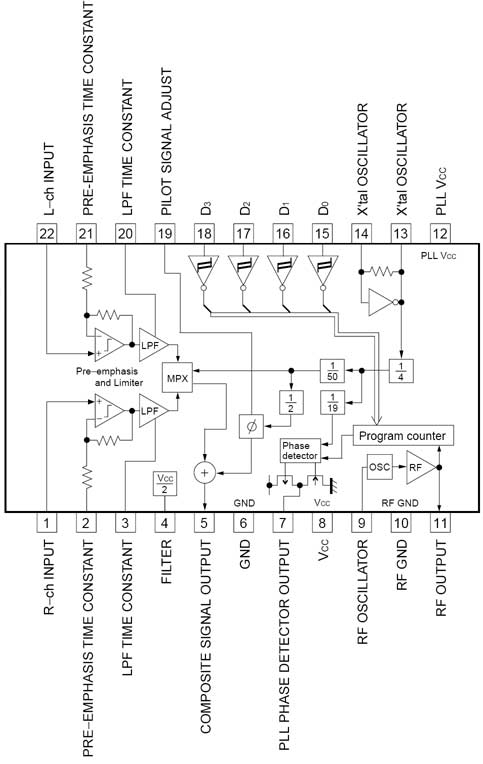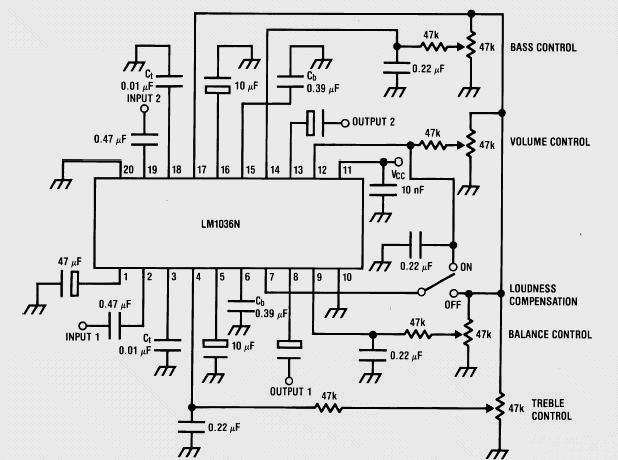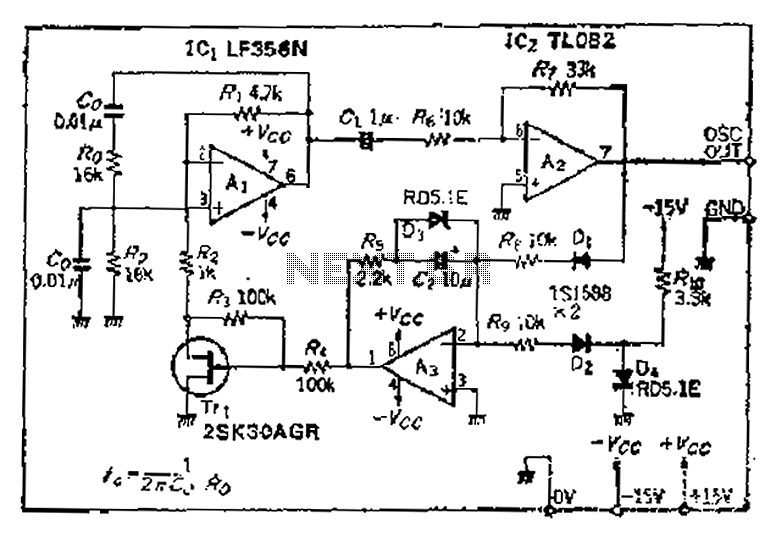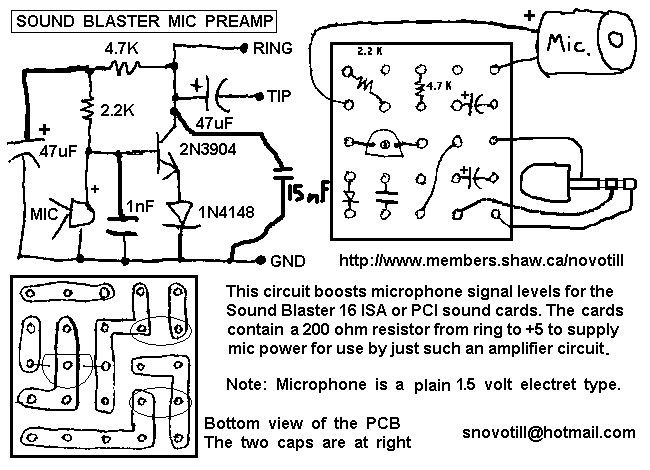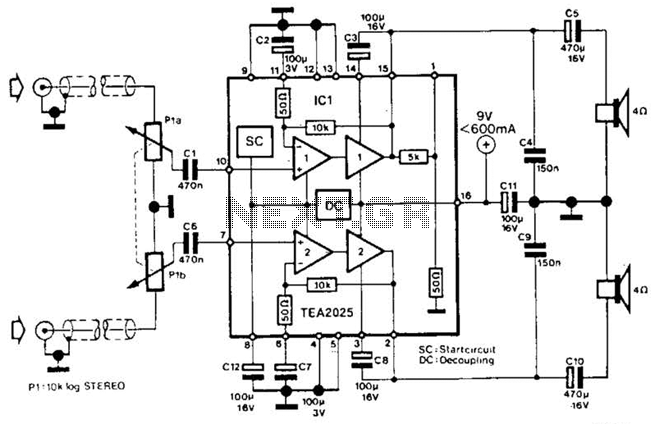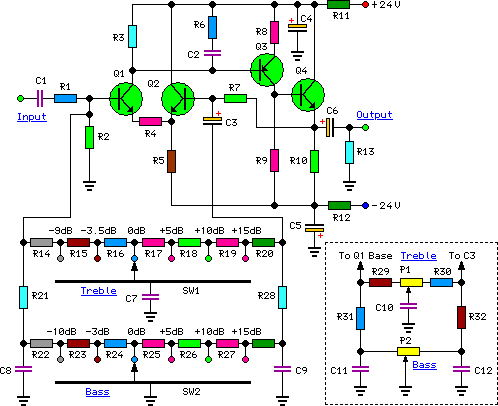
RIAA Compensated Stereo Preamp
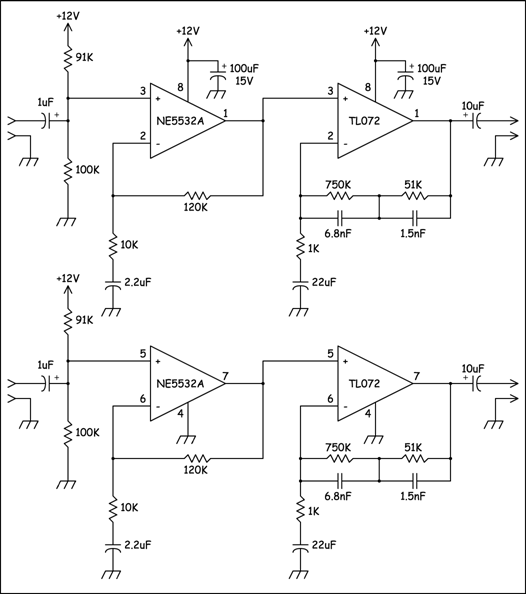
If a stereo amplifier lacks an input for a record player, it is advisable to utilize this circuit between the turntable and the amplifier. The output from the turntable adheres to a gain-bandwidth curve known as the RIAA compensation curve, which is not compatible with the standard AUX input on a stereo system. Without an RIAA preamp, records will sound distorted. The RIAA compensation curve was established in the mid-1950s to significantly enhance playback fidelity, taking into account the limitations of mechanical recording systems on the record surface. This amplifier offers 20 dB of gain at low frequencies, no gain at medium frequencies, and 20 dB of attenuation at high frequencies. The circuit employs two operational amplifier (Opamp) packages, each comprising dual Opamps, allowing the left and right channels to share one Opamp from each dual package. This circuit also serves as an example in the "Custom Etched Circuit Boards" section, where instructions for creating a custom circuit board for this preamp can be found. Full-size artwork for the circuit board design can be downloaded from that section.
The described circuit functions as a critical interface between a turntable and a stereo amplifier that lacks dedicated phono inputs. The RIAA preamplifier is essential for ensuring that the audio signal from vinyl records is appropriately processed, maintaining the integrity of the original sound recording. The RIAA equalization curve compensates for the inherent limitations of vinyl records, which are produced with varying levels of bass and treble frequencies to optimize the physical space on the record surface.
The circuit is designed around two dual operational amplifiers, which are versatile components that amplify electrical signals. The use of dual Opamp packages allows for efficient space utilization on the circuit board while providing the necessary amplification for both the left and right audio channels. The gain characteristics of the amplifier are tailored to match the RIAA curve: it amplifies low-frequency signals by 20 dB to counteract the natural roll-off of bass during the cutting process of vinyl records, maintains a flat response at mid frequencies, and attenuates high frequencies by 20 dB to prevent distortion and ensure a balanced output.
For those interested in custom circuit board creation, the instructions provided in the "Custom Etched Circuit Boards" section offer a step-by-step guide for designing and fabricating a tailored PCB for this preamp circuit. The availability of full-size artwork facilitates the process, allowing for precise layout and component placement, which is crucial for maintaining signal integrity and minimizing noise. This preamp circuit is not only functional but also serves as an educational tool for understanding the principles of audio signal processing and the importance of RIAA equalization in vinyl playback systems.If your stereo amplifier does not have an input for a record player, you should use this circuit between your turntable and your amplifier. The output of your turntable follows a gain-bandwidth curve called the RIAA compensation curve. The standard AUX input on your stereo does not. Records will sound very strange without an RIAA preamp. The RIAAcompensation curve was adopted in the mid 1950s, as a way of dramatically improving the fidelity of playback. This curve takes into account the limitations of the mechanican recording system on the record surface. At low frequencies, this amplifier provides 20dB of gain. At medium frequencies it provides no gain, and at high frequencies it provides 20dB of attenuation. Note that only two Opamp packages are used. Each type is actually a dual Opamp. The left and right amps share one amp of each type from each dual package. This circuit is also used as the example for the "Custom Etched Circuit Boards" section. In that section you will find instructions for making a custom circuit board for this preamp. If you want to make your own circuit board for this project, you can download full size artwork there as well.
🔗 External reference
The described circuit functions as a critical interface between a turntable and a stereo amplifier that lacks dedicated phono inputs. The RIAA preamplifier is essential for ensuring that the audio signal from vinyl records is appropriately processed, maintaining the integrity of the original sound recording. The RIAA equalization curve compensates for the inherent limitations of vinyl records, which are produced with varying levels of bass and treble frequencies to optimize the physical space on the record surface.
The circuit is designed around two dual operational amplifiers, which are versatile components that amplify electrical signals. The use of dual Opamp packages allows for efficient space utilization on the circuit board while providing the necessary amplification for both the left and right audio channels. The gain characteristics of the amplifier are tailored to match the RIAA curve: it amplifies low-frequency signals by 20 dB to counteract the natural roll-off of bass during the cutting process of vinyl records, maintains a flat response at mid frequencies, and attenuates high frequencies by 20 dB to prevent distortion and ensure a balanced output.
For those interested in custom circuit board creation, the instructions provided in the "Custom Etched Circuit Boards" section offer a step-by-step guide for designing and fabricating a tailored PCB for this preamp circuit. The availability of full-size artwork facilitates the process, allowing for precise layout and component placement, which is crucial for maintaining signal integrity and minimizing noise. This preamp circuit is not only functional but also serves as an educational tool for understanding the principles of audio signal processing and the importance of RIAA equalization in vinyl playback systems.If your stereo amplifier does not have an input for a record player, you should use this circuit between your turntable and your amplifier. The output of your turntable follows a gain-bandwidth curve called the RIAA compensation curve. The standard AUX input on your stereo does not. Records will sound very strange without an RIAA preamp. The RIAAcompensation curve was adopted in the mid 1950s, as a way of dramatically improving the fidelity of playback. This curve takes into account the limitations of the mechanican recording system on the record surface. At low frequencies, this amplifier provides 20dB of gain. At medium frequencies it provides no gain, and at high frequencies it provides 20dB of attenuation. Note that only two Opamp packages are used. Each type is actually a dual Opamp. The left and right amps share one amp of each type from each dual package. This circuit is also used as the example for the "Custom Etched Circuit Boards" section. In that section you will find instructions for making a custom circuit board for this preamp. If you want to make your own circuit board for this project, you can download full size artwork there as well.
🔗 External reference
